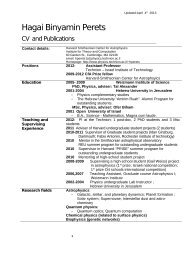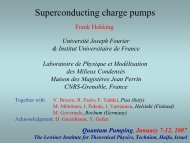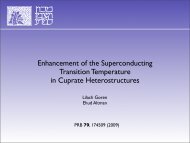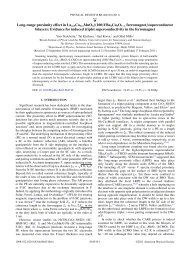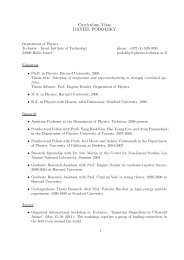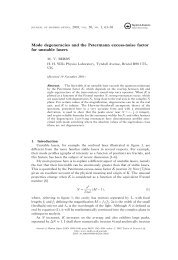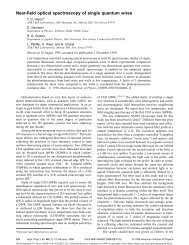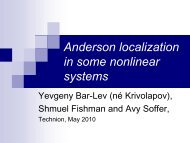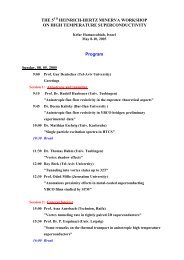High-power rf generation in a hollow-cathode - Physics@Technion
High-power rf generation in a hollow-cathode - Physics@Technion
High-power rf generation in a hollow-cathode - Physics@Technion
Create successful ePaper yourself
Turn your PDF publications into a flip-book with our unique Google optimized e-Paper software.
<strong>High</strong>-<strong>power</strong> radio frequency <strong>generation</strong> <strong>in</strong> a <strong>hollow</strong>-<strong>cathode</strong> discharge<br />
D. Arbel, Z. Bar-Lev, J. Felste<strong>in</strong>er, a) A. Rosenberg, and Ya. Z. Slutsker<br />
Physics Department, Technion-Israel Institute of Technology, 32000 Haifa, Israel<br />
�Received 23 September 1994; accepted for publication 10 January 1995�<br />
<strong>High</strong>-<strong>power</strong> <strong>rf</strong> oscillations are obta<strong>in</strong>ed <strong>in</strong> a resistive load <strong>in</strong>stalled <strong>in</strong> the external electrical circuit<br />
of a low-pressure magnetic-field-free <strong>hollow</strong>-<strong>cathode</strong> discharge. These <strong>in</strong>tense <strong>rf</strong> oscillations have<br />
been shown to be due to a collisionless <strong>in</strong>stability of the <strong>cathode</strong> sheath. A very simple device based<br />
on this effect is shown to serve as a convenient and <strong>power</strong>ful <strong>rf</strong> oscillator. Typical results first<br />
achieved without any optimization, for frequencies of 20–30 MHz and load resistances of several<br />
tens of ohms, are as follows: <strong>power</strong> of about 5 kW and efficiency �25%. © 1995 American<br />
Institute of Physics.<br />
We have obta<strong>in</strong>ed high <strong>rf</strong> <strong>power</strong> <strong>in</strong> the resistive load of a<br />
low-pressure <strong>hollow</strong>-<strong>cathode</strong> discharge. The <strong>rf</strong> oscillations <strong>in</strong><br />
the discharge current have been shown to be due to a<br />
<strong>cathode</strong>-sheath <strong>in</strong>stability <strong>in</strong> the discharge. 1 This <strong>in</strong>stability<br />
causes current oscillations with a frequency slightly lower<br />
than the ion plasma frequency near the <strong>cathode</strong>-sheath edge.<br />
The <strong>in</strong>stability appears when, for a certa<strong>in</strong> <strong>cathode</strong>-fall voltage,<br />
the time taken for the ions to cross the sheath is approximately<br />
equal to the period of the <strong>rf</strong> oscillations. A similar<br />
<strong>in</strong>stability is known for the electrons cross<strong>in</strong>g the sheath near<br />
a positively charged electrode. 2,3 In this letter we present<br />
experimental results show<strong>in</strong>g that a device based on this phenomenon<br />
can serve as a <strong>power</strong>ful <strong>rf</strong> oscillator.<br />
The experimental apparatus is shown <strong>in</strong> Fig. 1. We used<br />
a discharge tube composed of an open-ended cyl<strong>in</strong>drical<br />
<strong>cathode</strong>, 10 cm long, hav<strong>in</strong>g an <strong>in</strong>side diameter of 8.6 or 6.2<br />
cm. The anode shape, its diameter, its location, or its material<br />
had no <strong>in</strong>fluence on the experimental results. Typically, the<br />
anode was located at one of the ends of the <strong>cathode</strong> cyl<strong>in</strong>der.<br />
The <strong>cathode</strong> and anode were mounted <strong>in</strong>side a glass vacuum<br />
vessel filled with He. The operat<strong>in</strong>g pressure P had no significant<br />
<strong>in</strong>fluence on the experimental results provided that<br />
PD�3.0 Torr cm �here, D is the cyl<strong>in</strong>der diameter�. 1 Typical<br />
operat<strong>in</strong>g pressures were 0.1–0.2 Torr. The discharge was<br />
driven by a pulse generator with a pulse duration of 2 �s.<br />
The discharge current studied was <strong>in</strong> the range 5–50 A. The<br />
oscillations <strong>in</strong> the current appeared when the discharge current<br />
was above 6 A. In order to separate the average and <strong>rf</strong><br />
components of the discharge current a simple LC filter was<br />
used. A variable load resistor R was placed <strong>in</strong> series with the<br />
capacitor C �see Fig. 1�. The cutoff frequency of the filter<br />
was chosen to be �5 MHz, so that it was transparent to the<br />
2 �s pulse. The <strong>rf</strong> oscillations �which were above 20 MHz�<br />
were coupled through the capacitor C to the load R. The <strong>rf</strong><br />
current through R was measured by a Rogovsky coil. A typical<br />
scope trace of the <strong>rf</strong> current is shown <strong>in</strong> the <strong>in</strong>sert to Fig.<br />
1. The voltage across the tube was measured us<strong>in</strong>g a resistive<br />
divider. In Fig. 2 we show the dependence of the tube voltage<br />
V a on the average discharge current I a . It is seen that<br />
V a grows up monotonically with I a . For the range of I a<br />
between 5 and 50 A, the voltage V a varied just between 350<br />
a� Electronic mail: phr01ya@technion.technion.ac.il<br />
and 600 V. The voltages measured for different tube diameters<br />
and pressures were approximately the same.<br />
The dependence of the amplitude of the <strong>rf</strong> current I R<br />
through the load on the discharge current I a for two different<br />
<strong>cathode</strong> diameters and two different values of R are shown <strong>in</strong><br />
Fig. 3. It is seen that I R grows up monotonically with I a and<br />
under certa<strong>in</strong> conditions, namely a low value of R and a large<br />
<strong>cathode</strong> diameter, I R becomes closer to I a . When R is<br />
shorted, I R becomes comparable to I a , which is the same as<br />
the situation described <strong>in</strong> Ref. 1. In Fig. 4 we show the<br />
dependence of I R on the load resistance R for particular values<br />
of I a and <strong>cathode</strong> diameter. It is seen that I a decreases<br />
with <strong>in</strong>creas<strong>in</strong>g R. For different values of I a and <strong>cathode</strong><br />
diameters we obta<strong>in</strong>ed a similar behavior. From the data <strong>in</strong><br />
Fig. 4 it is easy to estimate the <strong>in</strong>ternal resistance R i of the<br />
present <strong>hollow</strong>-<strong>cathode</strong> <strong>rf</strong> generator device. We f<strong>in</strong>d<br />
R i�120 � for I a�38 A and 8.6 cm <strong>cathode</strong> diameter. The<br />
value of R i does not depend significantly on either I a or the<br />
<strong>cathode</strong> diameter. For example, for I a�15 A and 6.2 cm<br />
<strong>cathode</strong> diameter we get R i�100 �.<br />
It has been shown 1 that the oscillation frequency <strong>in</strong>creases<br />
either when the discharge current goes up or when<br />
the <strong>cathode</strong> diameter is reduced. We note that the value of<br />
the load resistance had no effect on the oscillation frequency.<br />
However, for a high value of the load resistance a slight<br />
<strong>in</strong>crease <strong>in</strong> the discharge current was needed to start the os-<br />
FIG. 1. Experimental apparatus. �1� Cathode cyl<strong>in</strong>der with 8.6 or 6.2 cm<br />
diameter; �2� anode; �3� 2 �H <strong>in</strong>ductor; �4� 660 pF capacitor; �5� load<br />
resistor; �6� Rogovsky coil; �7� typical scope trace of the <strong>rf</strong> current pass<strong>in</strong>g<br />
through the load resistor �sensitivity 5 A/div, time base 40 ns/div�.<br />
Appl. Phys. Lett. 66 (10), 6 March 1995 0003-6951/95/66(10)/1193/3/$6.00 © 1995 American Institute of Physics<br />
Downloaded¬23¬Jan¬2002¬to¬132.68.1.29.¬Redistribution¬subject¬to¬AIP¬license¬or¬copyright,¬see¬http://ojps.aip.org/aplo/aplcr.jsp<br />
1193
FIG. 2. Dependence of the tube voltage on the average discharge current.<br />
FIG. 3. Dependence of the peak <strong>rf</strong> current through the load on the average<br />
discharge current: �1� for 8.6 cm tube, 23 � load; �2� for 8.6 cm tube, 82 �<br />
load; �3� for 6.2 cm tube, 23 � load.<br />
FIG. 4. Dependence of the peak <strong>rf</strong> current through the load on the load<br />
resistance for 8.6 cm tube and 38 A discharge current.<br />
FIG. 5. Dependence of the <strong>rf</strong> <strong>power</strong> <strong>in</strong> the load �a� and of the efficiency �b�<br />
on the average discharge current: �1� for 8.6 cm tube, 82 � load; �2� for 8.6<br />
cm tube, 23 � load; and �3� for 6.2 cm tube, 23 � load.<br />
FIG. 6. Dependence of the <strong>rf</strong> <strong>power</strong> <strong>in</strong> the load �a� and of the efficiency �b�<br />
on the load resistance for 8.6 cm tube and 38 A discharge current.<br />
1194 Appl. Phys. Lett., Vol. 66, No. 10, 6 March 1995 Arbel et al.<br />
Downloaded¬23¬Jan¬2002¬to¬132.68.1.29.¬Redistribution¬subject¬to¬AIP¬license¬or¬copyright,¬see¬http://ojps.aip.org/aplo/aplcr.jsp
cillations. For example, when R�80 �, the oscillations<br />
started from Ia�10 A, compared to Ia�6 A for R�10 �.<br />
Know<strong>in</strong>g the peak <strong>rf</strong> current IR through the load and its<br />
resistance R, it is easy to calculate the output <strong>rf</strong> <strong>power</strong>; WR �I R<br />
2 R/2. A graph of WR as a function of I a is shown <strong>in</strong> Fig.<br />
5�a� for two different <strong>cathode</strong> diameters and two different<br />
values of R. As it is seen, the <strong>rf</strong> <strong>power</strong> grows up monotonically<br />
for both diameters and for both values of R. From Fig.<br />
2, for each value of I a one can obta<strong>in</strong> the dc <strong>power</strong> W<br />
�V aI a which drives the discharge. The ratio W R /W, which<br />
is the efficiency of this device as an <strong>rf</strong> generator, is shown <strong>in</strong><br />
Fig. 5�b� as a function of I a for the same values of R and<br />
diameters. It is seen that this ratio decreases as I a grows up.<br />
Figs. 6�a� and 6�b� show, respectively, the output <strong>rf</strong> <strong>power</strong><br />
and the efficiency versus the load resistance, for certa<strong>in</strong> values<br />
of discharge current and <strong>cathode</strong> diameter. It is seen that<br />
both the <strong>rf</strong> <strong>power</strong> and the efficiency are maximal at about<br />
120 �. Similar curves, with a maximum at about the same<br />
place, were obta<strong>in</strong>ed for different values of discharge current<br />
<strong>in</strong> the <strong>in</strong>vestigated range of 10–45 A. Note that the maximal<br />
<strong>power</strong> occurs when the value of the load resistance R is close<br />
to that of the <strong>in</strong>ternal <strong>rf</strong> resistance R i .<br />
To conclude, the present very simple device can be used<br />
as a new k<strong>in</strong>d of a pulsed <strong>rf</strong> <strong>power</strong> generator, with an output<br />
<strong>power</strong> of 4 –5 kW and efficiency of about 25%. This efficiency<br />
is comparable to that of conventional <strong>rf</strong> <strong>power</strong> generators.<br />
The present results have been obta<strong>in</strong>ed without optimization<br />
of the device so more efficiency and <strong>power</strong> can, <strong>in</strong><br />
fact, be expected. The advantages of this device are simplicity<br />
and very low cost. F<strong>in</strong>ally, we also note that this device<br />
has an <strong>in</strong>stantaneous start<strong>in</strong>g which is an advantage over<br />
conventional <strong>power</strong>ful hot-<strong>cathode</strong> electron tubes.<br />
This research was supported <strong>in</strong> part by Technion V. P. R.<br />
Fund-Harry Werksman Research Fund.<br />
1<br />
D. Arbel, Z. Bar-Lev, J. Felste<strong>in</strong>er, A. Rosenberg, and Ya. Z. Slutsker,<br />
Phys. Rev. Lett. 71, 2919 �1993�.<br />
2<br />
R. L. Stenzel, Phys. Rev. Lett. 60, 704 �1988�; Phys. Fluids B 1, 2273<br />
�1989�.<br />
3<br />
Yu. Ya. Brodskii, S. I. Nechuev, Ya. Z. Slutsker, A. M. Feig<strong>in</strong>, and G. M.<br />
Fraiman, Fiz. Plazmy 15, 1187 �1989� �Sov. J. Plasma Phys. 15, 688<br />
�1989��.<br />
Appl. Phys. Lett., Vol. 66, No. 10, 6 March 1995 Arbel et al.<br />
Downloaded¬23¬Jan¬2002¬to¬132.68.1.29.¬Redistribution¬subject¬to¬AIP¬license¬or¬copyright,¬see¬http://ojps.aip.org/aplo/aplcr.jsp<br />
1195





